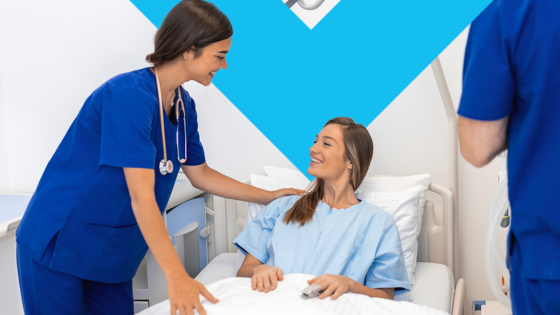Patient attends hospital for birth of child
Lowering Surgical Site Infections and Readmissions in Maternity Care
The Challenge
A surgical site infection (SSI) is one of the most common complications of caesarean section (CS) surgery, with an average UK incidence rate of 9.6% and 0.6% recurrence rate 1 .
It is associated with significant morbidity, increased use of antibiotics, prolonged hospital visits, wound dehiscence (the partial or total separation of previously approximated wound edges due to a failure of wound healing), sepsis (a life-threatening reaction of the body to infection) and occasionally maternal death.

As CS rates continue to increase globally, particularly with growing antimicrobial resistance, the risk posed by SSI will also increase.
In 2021, Barking, Havering and Redbridge University Hospitals NHS Trust (BHRUT) underwent an internal audit, which showed an overall CS infection rate of 6.1%.
In response to this, the Maternity Department sought to change their clinical practices to improve outcomes for CS patients. In January 2022 the trust began a 12 month trial of the Leukomed DACC-coated (Dialkylcarbamoyl Chloride) dressing .
The rise in caesarean section rates internationally has further increased the importance of preventing surgical site infections (SSI). By switching to DACC-coated bacteria binding dressings, for all patients undergoing a caesarean section, SSI reduced by 38%, resulting in fewer readmissions to hospital and improving the postnatal experience for patients.
Michael Magro, Consultant Obstetrician and Gynaecologist and Labour Ward Lead,
Barking, Havering and Redbridge University Hospitals NHS Trust

The Aim
To identify if the use of the DACC-coated, bacteria-binding dressing could achieve reductions in the following:
- SSI rate
- SSI related re-admissions (rate/day)
- Antibiotic usage
- Associated system-wide costs.
The Solution
A DACC-coated, bacteria-binding dressing is a sterile, single use surgical post-operative film dressing, with bacteria-binding properties, that is applied in the operating theatre at the end of a caesarean section procedure.
The DACC coating is hydrophobic and allows the dressing to physically bind, inhibit and remove microorganisms commonly responsible for SSIs. Bacteria, fungi, and endotoxins are bound irreversibly and physically removed from the wound upon dressing removal, helping to reduce the bioburden of the wound and promote healing.
A case for change was developed specifically for BHRUT, outlining the clinical and financial benefits of switching to the a DACC-coated, bacteria-binding dressing.
In January 2022 the Maternity Department replaced non-woven island dressings with a DACC-coated, bacteria-binding dressings, for all surgical wounds post-caesarean section, regardless of BMI, smoking status, age or any co-morbidities that increase infection risk. The dressing stayed in place for five days, unless extenuating circumstances required earlier removal. In contrast, the non-woven island dressing would remain in place for 24 hours. No other changes in practice were made other than the new dressing.
The Process
A caesarean dressing pathway was developed and signed off ahead of implementation. The supplier of the dressing, created and implemented a two week training plan to facilitate consistency across all clinical teams in both acute and community. The Quality Improvement (QI) Project was registered with the trust’s Clinical Audit Department and approval was obtained before any data collection took place.
A retrospective audit was conducted for all caesarean sections performed between 1 January 2021 and 12 December 2021, which established the baseline SSI rate to compare the a DACC-coated, bacteria-binding dressing to. The Clinical Auditors pulled patient reports from the electronic systems and manually filled any gaps in information from patient records. In total 2,436 patients were audited for the pre-implementation period.
SSIs were identified by any clinical notation stating an SSI, or wound infection, had occurred (or was treated for) up to six weeks post-operation. Patients who developed SSIs were identified through readmission episodes, wound swabs, antibiotics use and additional notation on community complications from the final midwife discharge call. This was advantageous for the project as it meant infections managed entirely within the community could also be accounted for, building a more accurate picture of infection rates following caesarean section.
The dressing was implemented on 12 December 2021, with a three week adjustment period allowing for the trust to become accustomed to the new dressing. A prospective audit was then conducted for CS surgeries performed between 1 January and 12 December 2022. The same methodology employed for the retrospective audit was applied here and in total 2,368 patients were audited for the post-implementation period.
A visual representation of the clinical care pathway before and after the implementation of a DACC-coated, bacteria-binding dressing:
Before
Pre-operative steps take place in line with trust policy
Patient has a c-section operation
Standard dressing applied post-op for 24 hours
Patient discharged
Patient develops SSI post surgery
Patient readmitted to treat SSI
Patient is treated in trust’s inpatient department
Patient discharged to community
Standard follow up continues by health visitors
After
Patient attends hospital for birth of child
Pre-operative steps take place in line with trust policy
Patient has a c-section operation
DACC-coated, bacteria-binding dressing applied
Dressing stays in place for 5 days post c-section (unless clinical need suggests earlier)
Patient discharged to community
Standard follow up continues by health visitors
The Outcome
- 37.7% SSI reduction rate
- SSI-related re-admissions dropped by 29.4%, and the total number of days patients spent in hospital due to SSI fell by 38.8%
- 30.4% reduction in antibiotic usage.
- £49,750 trust saving (using PLICS data)
- £234,784 saving in associated system-wide costs.
*Please note that the SSI system figure, referenced from the Jenks et al 2014 study 2, has been adjusted to account for the rate of inflation.
Further Opportunities
As stated in the NICE MTG-55 3, evidence supports the case for adopting Leukomed Sorbact for closed surgical wounds after Vascular Surgery.
The guidance also states that comments from clinical experts about the benefits of a DACC-coated, bacteria-binding dressings were positive, noting that it seemed to reduce SSI and was easy to use.
The clinical experts were broadly optimistic that this dressing could be useful for other types of surgery and that more clinical evidence in these areas was encouraged.
Next Steps
To discuss this case study, and opportunities for your trust to explore using this product, please contact:
Kirsty Wiggins
Category Manager – Rehabilitation and Community
kirsty.wiggins@supplychain.nhs.uk
07783 150 400
References
1 Magro M: Reducing Surgical Site Infections Post-Caesarean Section – Reducing Surgical Site Infections Post-Caesarean Section | IJWH (dovepress.com)
2 PJ Jenks, M. Laurent, S. McQuarry, R. Watkins. (2014) – Clinical and economic burden of surgical site infection (SSI) and predicted financial consequences of elimination of SSI from an English hospital
3 NICE Guidance: Leukomed Sorbact for Preventing Surgical Site Infections – Committee discussion | Leukomed Sorbact for preventing surgical site infection | Guidance | NICE
